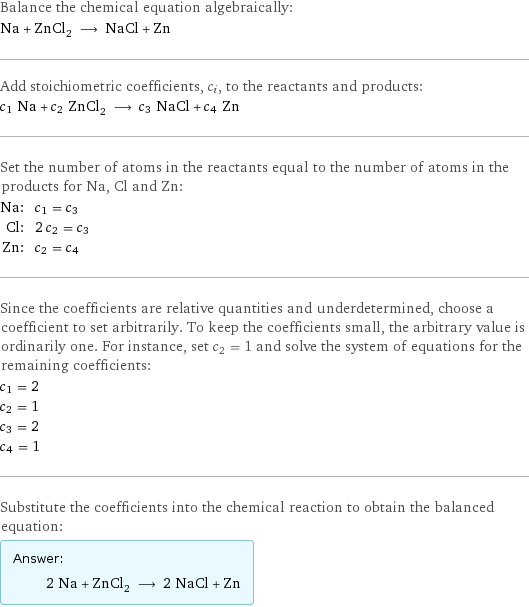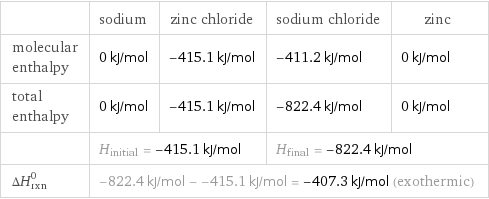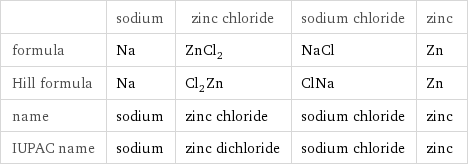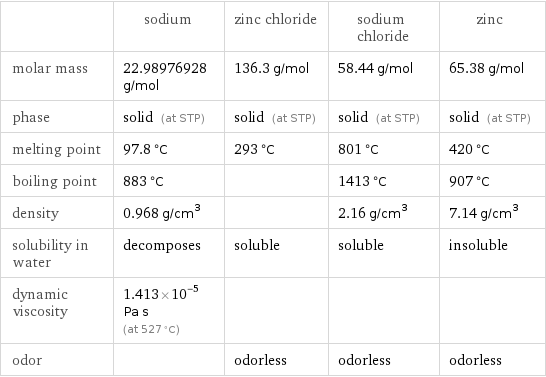Input interpretation

Na sodium + ZnCl_2 zinc chloride ⟶ NaCl sodium chloride + Zn zinc
Balanced equation

Balance the chemical equation algebraically: Na + ZnCl_2 ⟶ NaCl + Zn Add stoichiometric coefficients, c_i, to the reactants and products: c_1 Na + c_2 ZnCl_2 ⟶ c_3 NaCl + c_4 Zn Set the number of atoms in the reactants equal to the number of atoms in the products for Na, Cl and Zn: Na: | c_1 = c_3 Cl: | 2 c_2 = c_3 Zn: | c_2 = c_4 Since the coefficients are relative quantities and underdetermined, choose a coefficient to set arbitrarily. To keep the coefficients small, the arbitrary value is ordinarily one. For instance, set c_2 = 1 and solve the system of equations for the remaining coefficients: c_1 = 2 c_2 = 1 c_3 = 2 c_4 = 1 Substitute the coefficients into the chemical reaction to obtain the balanced equation: Answer: | | 2 Na + ZnCl_2 ⟶ 2 NaCl + Zn
Structures

+ ⟶ +
Names

sodium + zinc chloride ⟶ sodium chloride + zinc
Reaction thermodynamics
Enthalpy

| sodium | zinc chloride | sodium chloride | zinc molecular enthalpy | 0 kJ/mol | -415.1 kJ/mol | -411.2 kJ/mol | 0 kJ/mol total enthalpy | 0 kJ/mol | -415.1 kJ/mol | -822.4 kJ/mol | 0 kJ/mol | H_initial = -415.1 kJ/mol | | H_final = -822.4 kJ/mol | ΔH_rxn^0 | -822.4 kJ/mol - -415.1 kJ/mol = -407.3 kJ/mol (exothermic) | | |
Equilibrium constant
![Construct the equilibrium constant, K, expression for: Na + ZnCl_2 ⟶ NaCl + Zn Plan: • Balance the chemical equation. • Determine the stoichiometric numbers. • Assemble the activity expression for each chemical species. • Use the activity expressions to build the equilibrium constant expression. Write the balanced chemical equation: 2 Na + ZnCl_2 ⟶ 2 NaCl + Zn Assign stoichiometric numbers, ν_i, using the stoichiometric coefficients, c_i, from the balanced chemical equation in the following manner: ν_i = -c_i for reactants and ν_i = c_i for products: chemical species | c_i | ν_i Na | 2 | -2 ZnCl_2 | 1 | -1 NaCl | 2 | 2 Zn | 1 | 1 Assemble the activity expressions accounting for the state of matter and ν_i: chemical species | c_i | ν_i | activity expression Na | 2 | -2 | ([Na])^(-2) ZnCl_2 | 1 | -1 | ([ZnCl2])^(-1) NaCl | 2 | 2 | ([NaCl])^2 Zn | 1 | 1 | [Zn] The equilibrium constant symbol in the concentration basis is: K_c Mulitply the activity expressions to arrive at the K_c expression: Answer: | | K_c = ([Na])^(-2) ([ZnCl2])^(-1) ([NaCl])^2 [Zn] = (([NaCl])^2 [Zn])/(([Na])^2 [ZnCl2])](../image_source/0f74cc8d3abbc3b39085a0ff01d7895e.png)
Construct the equilibrium constant, K, expression for: Na + ZnCl_2 ⟶ NaCl + Zn Plan: • Balance the chemical equation. • Determine the stoichiometric numbers. • Assemble the activity expression for each chemical species. • Use the activity expressions to build the equilibrium constant expression. Write the balanced chemical equation: 2 Na + ZnCl_2 ⟶ 2 NaCl + Zn Assign stoichiometric numbers, ν_i, using the stoichiometric coefficients, c_i, from the balanced chemical equation in the following manner: ν_i = -c_i for reactants and ν_i = c_i for products: chemical species | c_i | ν_i Na | 2 | -2 ZnCl_2 | 1 | -1 NaCl | 2 | 2 Zn | 1 | 1 Assemble the activity expressions accounting for the state of matter and ν_i: chemical species | c_i | ν_i | activity expression Na | 2 | -2 | ([Na])^(-2) ZnCl_2 | 1 | -1 | ([ZnCl2])^(-1) NaCl | 2 | 2 | ([NaCl])^2 Zn | 1 | 1 | [Zn] The equilibrium constant symbol in the concentration basis is: K_c Mulitply the activity expressions to arrive at the K_c expression: Answer: | | K_c = ([Na])^(-2) ([ZnCl2])^(-1) ([NaCl])^2 [Zn] = (([NaCl])^2 [Zn])/(([Na])^2 [ZnCl2])
Rate of reaction
![Construct the rate of reaction expression for: Na + ZnCl_2 ⟶ NaCl + Zn Plan: • Balance the chemical equation. • Determine the stoichiometric numbers. • Assemble the rate term for each chemical species. • Write the rate of reaction expression. Write the balanced chemical equation: 2 Na + ZnCl_2 ⟶ 2 NaCl + Zn Assign stoichiometric numbers, ν_i, using the stoichiometric coefficients, c_i, from the balanced chemical equation in the following manner: ν_i = -c_i for reactants and ν_i = c_i for products: chemical species | c_i | ν_i Na | 2 | -2 ZnCl_2 | 1 | -1 NaCl | 2 | 2 Zn | 1 | 1 The rate term for each chemical species, B_i, is 1/ν_i(Δ[B_i])/(Δt) where [B_i] is the amount concentration and t is time: chemical species | c_i | ν_i | rate term Na | 2 | -2 | -1/2 (Δ[Na])/(Δt) ZnCl_2 | 1 | -1 | -(Δ[ZnCl2])/(Δt) NaCl | 2 | 2 | 1/2 (Δ[NaCl])/(Δt) Zn | 1 | 1 | (Δ[Zn])/(Δt) (for infinitesimal rate of change, replace Δ with d) Set the rate terms equal to each other to arrive at the rate expression: Answer: | | rate = -1/2 (Δ[Na])/(Δt) = -(Δ[ZnCl2])/(Δt) = 1/2 (Δ[NaCl])/(Δt) = (Δ[Zn])/(Δt) (assuming constant volume and no accumulation of intermediates or side products)](../image_source/6adf9988667ad2879d851af1535f0d9a.png)
Construct the rate of reaction expression for: Na + ZnCl_2 ⟶ NaCl + Zn Plan: • Balance the chemical equation. • Determine the stoichiometric numbers. • Assemble the rate term for each chemical species. • Write the rate of reaction expression. Write the balanced chemical equation: 2 Na + ZnCl_2 ⟶ 2 NaCl + Zn Assign stoichiometric numbers, ν_i, using the stoichiometric coefficients, c_i, from the balanced chemical equation in the following manner: ν_i = -c_i for reactants and ν_i = c_i for products: chemical species | c_i | ν_i Na | 2 | -2 ZnCl_2 | 1 | -1 NaCl | 2 | 2 Zn | 1 | 1 The rate term for each chemical species, B_i, is 1/ν_i(Δ[B_i])/(Δt) where [B_i] is the amount concentration and t is time: chemical species | c_i | ν_i | rate term Na | 2 | -2 | -1/2 (Δ[Na])/(Δt) ZnCl_2 | 1 | -1 | -(Δ[ZnCl2])/(Δt) NaCl | 2 | 2 | 1/2 (Δ[NaCl])/(Δt) Zn | 1 | 1 | (Δ[Zn])/(Δt) (for infinitesimal rate of change, replace Δ with d) Set the rate terms equal to each other to arrive at the rate expression: Answer: | | rate = -1/2 (Δ[Na])/(Δt) = -(Δ[ZnCl2])/(Δt) = 1/2 (Δ[NaCl])/(Δt) = (Δ[Zn])/(Δt) (assuming constant volume and no accumulation of intermediates or side products)
Chemical names and formulas

| sodium | zinc chloride | sodium chloride | zinc formula | Na | ZnCl_2 | NaCl | Zn Hill formula | Na | Cl_2Zn | ClNa | Zn name | sodium | zinc chloride | sodium chloride | zinc IUPAC name | sodium | zinc dichloride | sodium chloride | zinc
Substance properties

| sodium | zinc chloride | sodium chloride | zinc molar mass | 22.98976928 g/mol | 136.3 g/mol | 58.44 g/mol | 65.38 g/mol phase | solid (at STP) | solid (at STP) | solid (at STP) | solid (at STP) melting point | 97.8 °C | 293 °C | 801 °C | 420 °C boiling point | 883 °C | | 1413 °C | 907 °C density | 0.968 g/cm^3 | | 2.16 g/cm^3 | 7.14 g/cm^3 solubility in water | decomposes | soluble | soluble | insoluble dynamic viscosity | 1.413×10^-5 Pa s (at 527 °C) | | | odor | | odorless | odorless | odorless
Units
